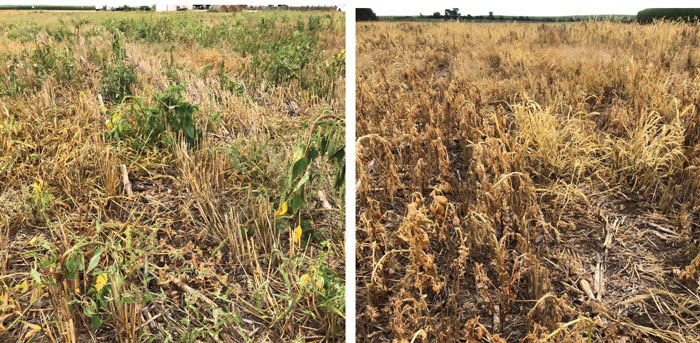For Jeff Wessels, precision ag manager and research agronomist with Frenchman Valley Coop, his biggest issue is broadleaf weeds. Working with farmers in McCook, Neb., and Pine Bluff, Wyo., he says that kochia and Palmer amaranth quickly developed a resistance to Pursuit (imazethapyr), Raptor (imazamox) and Roundup (glyphosate) after years of back-to-back usage without rotation or product variety.
In 2023, undesirable planting conditions and continued dry weather resulted in poor stands and high weed pressure. The lack of rain prevented many farmers from spraying any herbicide at all until they finally did get moisture.
“From southern Kansas up through our area in Nebraska, there was a lot of Sharpen sprayed just so you could find the wheat through the kochia to harvest it,” Wessels says.
High weed pressure, drought conditions and herbicide resistance have prompted Wessels to approach weed control differently. The 3 problems that he’s identified are that farmers are not applying enough herbicide, are not applying herbicides at the right time and are using the same herbicides too frequently, all leading to herbicide resistance.
Application Method, Quantity & Timing
Increased nozzle pressure does not equate to more herbicide applied, says Wessels, who prefers flat fan nozzles and a lower psi to get the most effective coverage. In 2018, Wessels’ operators sprayed at 60-65 pounds of nozzle pressure with the thought that it would penetrate the weed cover and reach the ground.
“I have pictures showing it killed the top half of the weeds, but the bottom half of the weeds got nothing on it,” he says. “This isn’t an airplane. There’s no wind vortex forcing the herbicide down.”
After testing different types of nozzles, including bidirectional and air induction, Wessels concluded that flat fan nozzles are most effective at getting the herbicide on the ground and close to the roots. Along with proper nozzles that prevent drift, he reduced pressure to 28-35 psi instead of spraying at higher pressures.
“When we were spraying at 60 psi with no wind, you could look straight across the field and see the spray hanging in the air,” Wessels says. “The added pressure wasn’t forcing it through the crop canopy, so we were getting horrible performance.”
“After 2 residual herbicide applications on non-GMO edible beans, there were 3 Palmer plants in the whole field…”
He has also seen a combination of too much wind, improper nozzles and too little herbicide burn one side of a weed but not the other. When farmers apply too little herbicide because they don’t want to haul more water per acre, multiple applications are often required, especially in dry conditions where weeds are drought-stressed.
“When you have a wet year and there’s humidity, temperatures are lower and the weeds are actively growing, you can kill a 4-foot tall weed much easier than a 6-inch tall drought-stressed weed,” Wessels says.
He prefers minimal wind, lower psi and higher quantities of herbicide regardless of weather conditions to ensure proper coverage and minimize drift. Many farmers Wessels works with do not apply herbicide at label rates, thinking smaller weeds require less herbicide. According to Wessels, some apply 5 ounces of Status (dicamba) when the label allows for 10 ounces or 8 ounces of DiFlexx (dicamba) when the label says 16 ounces. Ineffective herbicide application builds tolerance in weeds, which reduces options for farmers and harms crops.
“When we were applying 24 ounces of glyphosate, a farmer told us that 10 ounces was working for him and that we were selling too much. 10 years later, he came up to me and said that all he did was make his weeds herbicide resistant faster than the rest of the countryside because he was spraying at low rates,” Wessels says.
Another contributing factor to herbicide resistance is spraying too little at the wrong time. In Wessels’ part of the country, post applying anything after June 6-10 is ineffective because of how fast broadleaf weeds, such as Palmer amaranth, metabolize. Additionally, temperatures above 90 degrees F accelerate Palmer’s metabolism. This means that weeds will simply digest the herbicide and continue growing.
Cheap Programs, Cheap Results
As many farmers are facing glyphosate-resistant weeds after years of repeated use, Wessels found that Gramoxone (paraquat) was a good replacement.
“In our countryside, glyphosate is great for grasses to a point, but once you get to the reproductive stage of a grass, Gramoxone does a better job than glyphosate after the vegetative state,” Wessels says. “Gramoxone is a desiccant. If it burns everything off — even if the seed head’s still in the boot stage — it works great.”
“Doing it cheap was yielding cheap results…”
Because proper coverage is key to Gramoxone’s effectiveness, he recommends spraying at least 25 gallons per acre. However, Wessels finds that farmers aren’t always willing to spend a little more per acre to get sufficient herbicide coverage. For example, while non-ionic adjuvants may be slightly more affordable than methylated seed oil per acre, he says, it costs additional time and money to respray after an ineffective non-ionic application.
“Doing it cheap was yielding cheap results,” Wessels says. “Nobody was happy, but we just kept doing the same thing. I’m a very strong believer in the idea that some company rebate programs are not the best thing for the farmer. We have to do what’s right for the farmer, period. That means if a combination of products from Syngenta, BASF and Bayer is the best thing for the farmer, that’s what I’ll do.”
Diversification is Key
To combat weed stress and herbicide resistance, Wessels advocates returning to the days before Roundup Ready crops. This means instead of weak pre- or post-emergence herbicide programs, stick to layers of residual applications. Spring and fall are ideal times for applying residuals because the moisture at these times of year will incorporate the herbicides into the ground.
“We would do 2 applications of residual herbicides on our edible beans, which did not have GMO traits, and there would be 3 Palmer plants in the whole field,” he says. “The soybean field right beside it with all the genetics was solid weeds despite spraying.”
Using a half-rate of residuals pre-emergence and then spraying another half-rate within 21-28 days regardless if any weeds have sprouted worked best for Wessels. Getting residual herbicides down before weed germination will prevent bigger issues down the line, he says.

ROTATING HERBICIDES. In a test plot, Wessels applied glyphosate (L) and Gramoxone (R). Because of the weeds’ resistance to glyphosate after repeated usage, the Gramoxone was better at eliminating all weed pressure. Photo by: Jeff Wessels
The second strategy that he uses is planting cover crops, which began as a way to protect young corn plants from wind following soybeans or corn silage. Along with weed control benefits, cover crops, such as cereal rye, will conserve moisture in the soil for the following crop, which helps in areas with minimal rainfall or that are experiencing drought conditions. Wessels’ advice is to think outside the box when it comes to weed control.
“Apply a half-rate of acetochlor or metolachlor pre-emergence and then Prowl (pendimethalin)post-emergence or vice versa with soybeans,” he says. “There are also products you can apply in the fall, such as Bicep (atrazine, S-metolachlor). In the spring, we applied 3 ounces of Zaltus SX (flumioxazin) to alternating 90-foot strips, keeping everything else the same.”
In the results of Wessels’ Zaltus field trial, strips where Zaltus SX was not applied showed kochia emergence, whereas strips with Zaltus had no weed emergence. Another round of Zaltus was applied 14 days before planting corn, and it did not kill the kochia in the strips without a fall application. In strips with a fall and spring application, no kochia grew.
Experimenting with herbicide applications to find what works best for individual farms will create the best management strategy, according to Wessels. Rotating modes of action is another important factor in creating an effective weed control plan that will minimize herbicide resistance.
“That’s what got most of us in trouble is using the same mode of action on corn, soybeans and wheat,” Wessels says. “We’re discovering we have kochia that’s sulfonylurea- and dicamba-resistant because we’re using it on our soybeans and corn. So the best plan is a Zaltus product or a Flumi (flumioxazin) product. It’s been around forever, but that weed hasn’t seen that chemistry in a long time. Do that for 2-3 years, then keep changing it up.”







